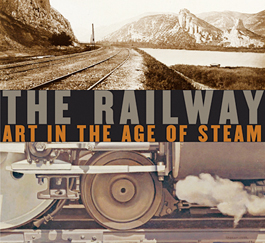home | metro silicon valley index | the arts | books | review

The Railway
Art in the Age of Steam
By Michael S. Gant
The railroad was a great agent of transformation in the 19th century. Passengers were stunned by the experience of locomotive travel; Thomas Carlyle, as Thomas Freeman writes in his introduction to The Railway: Art in the Age of Steam, described a train trip as a "Faustian flight, a ride on the devil's mantle." This sumptuously illustrated, oversize volume analyzes the impact of the railroad on artists, novelists and poets from the 1830s to the end of the steam era after Word War II. Early authors emphasized the speed of trains. According to Freeman, some people likened the experience of the rushing train to the "succession of images" seen in a magic lantern; for riders, the "view from the carriage window became a kind of cinematic encounter," almost as if the windows were film frames. The abundant images include a satirical cartoon by Daumier in which passengers sit on open benches atop a rail car, and a shrieking man grasps futilely at his blown-away top hat. In Turner's painting Rain, Steam, and Speed—The Great Western Railway, a hellishly glowing locomotive rushes toward the viewer with what scholar Ian Kennedy calls the "force of nature." Many painters used railroads as the setting for dramatic (and kitschy) vignettes of parents bidding farewell to sons, and wives waiting for husbands. The Hudson River painters incorporated the train into the vast new American landscape, often as a tiny smoke-chugging dot. More ominously, Andrew Melrose's Westward the Star of Empire Takes Its Way—Near Council Bluffs, Iowa puts the viewer on the tracks as a loco approaches at full speed against a sickly-green sky. The Impressionists didn't paint trains that often (except for Claude Monet) but liked to travel by train to their favorite rural view corridors. In the early 20th century, the speed and power of locomotives excited the Futurists and Constructivists, while Surrealists like De Chirico were disquieted. The book does a great service by rescuing the little-known Surrealist Paul Delvaux, who mixed gnomic nudes with empty train cars. The final elegy belongs to the remarkable railfan photographer O. Winston Link, whose elaborate night-time image Hot Shot Eastbound, Iaeger, West Virginia (1956) shows a steam-belching anachronism charging past a drive-in theater screening a movie about jet planes. It is as beautifully staged as a Jeff Wall mural. (By Ian Kennedy and Julian Treuherz; Yale University Press; 288 pages; $65 hardback)
Send a letter to the editor about this story.
|
|
|
|
|
|